Readings Newsletter
Become a Readings Member to make your shopping experience even easier.
Sign in or sign up for free!
You’re not far away from qualifying for FREE standard shipping within Australia
You’ve qualified for FREE standard shipping within Australia
The cart is loading…






This title is printed to order. This book may have been self-published. If so, we cannot guarantee the quality of the content. In the main most books will have gone through the editing process however some may not. We therefore suggest that you be aware of this before ordering this book. If in doubt check either the author or publisher’s details as we are unable to accept any returns unless they are faulty. Please contact us if you have any questions.
Sociologist Gerhard Falk examines the social psychology that motivates this process of exclusion, focusing on the outcasts in contemporary American society and comparing current experience with examples from the past. Referring to the work of Emile Durkheim and Erving Goffman, Falk reviews the whole range of stigmatised people from the mentally ill to ordinary people with unpopular occupations, like undertakers and trash collectors. Amid the wide diversity of stigmatised persons, he finds two basic types of outsiders: the ‘existential’ and the ‘achieved’. The first group comprises those who are stigmatised because of their very existence, regardless of their specific actions: the mentally handicapped, for example. The second group describes those whose actions or life conditions have resulted in stigma: from high achievers (often subject to resentment) to criminals. Falk also looks at the ways in which writers past and present have dramatised stigmatised characters in literature. This fascinating overview of a long-standing and widespread social problem will be of interest to all those concerned about creating a more fair-minded society.
$9.00 standard shipping within Australia
FREE standard shipping within Australia for orders over $100.00
Express & International shipping calculated at checkout
This title is printed to order. This book may have been self-published. If so, we cannot guarantee the quality of the content. In the main most books will have gone through the editing process however some may not. We therefore suggest that you be aware of this before ordering this book. If in doubt check either the author or publisher’s details as we are unable to accept any returns unless they are faulty. Please contact us if you have any questions.
Sociologist Gerhard Falk examines the social psychology that motivates this process of exclusion, focusing on the outcasts in contemporary American society and comparing current experience with examples from the past. Referring to the work of Emile Durkheim and Erving Goffman, Falk reviews the whole range of stigmatised people from the mentally ill to ordinary people with unpopular occupations, like undertakers and trash collectors. Amid the wide diversity of stigmatised persons, he finds two basic types of outsiders: the ‘existential’ and the ‘achieved’. The first group comprises those who are stigmatised because of their very existence, regardless of their specific actions: the mentally handicapped, for example. The second group describes those whose actions or life conditions have resulted in stigma: from high achievers (often subject to resentment) to criminals. Falk also looks at the ways in which writers past and present have dramatised stigmatised characters in literature. This fascinating overview of a long-standing and widespread social problem will be of interest to all those concerned about creating a more fair-minded society.